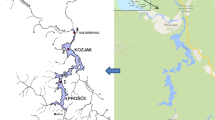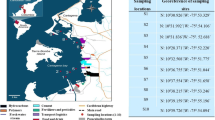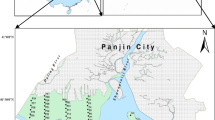Abstract
Introduction
The future ‘Calanque National Park’ coastlines of the Bouches-du-Rhône and Var departments in France, constitute one of the ten biodiversity hot spots identified in the Mediterranean basin that receives industrial and urban wastewaters discharged from Marseille and its suburbs.
Materials and methods
Organochlorine pesticides (OCs) and polychlorinated biphenyls (PCBs) were measured in sediments collected from 12 sampling sites (C1–C12) of sewage discharge to the sea from the wastewater treatment plant of Cortiou-Marseille. This study aims to determine the extent of these compounds in the sediments and to establish the possible sources of these contaminants.
Results and discussion
Total pesticides in the sediments ranged from 1.2 to 190.6 ng g-1 dry weight of sediment. The highest value was found at station C1, with a decreasing trend in total OC concentrations seaward. Among these compounds, the concentrations of the sum of dichlorodiphenyltrichloroethane (∑DDT) were the highest, ranging from 0.7 to 114.3 ng g-1. PCB concentrations, expressed as equivalent to Arochlor 1260, varied from 9.1 to 226.9 ng g-1. Individually, the dominant coplanar PCB congeners CB-153, CB-138 and CB-101. Generally, PCB concentrations at stations C2, C3, C5 and C7 were higher than those at stations C10, C11 and C12. Through some pollution indices, we showed the long-term contamination input of these OCs (DDT, endosulfan, HCH and heptachlor cases) rather than a recent release resulting from degradation and long-term weathering (dieldrin, aldrin and methoxychlor cases). Occurrence of PCBs might be due to their resistance to degradation processes or/and chronic inputs.
Conclusions
By comparison with available sediment quality guideline (SQG) values, the environmental significance and toxicological implications of PCBs and OCs (i) reveal the probable adverse effects for the sediments from C1, C5, C6, C9 and (ii) confirm the adverse effect for marine biota and more particularly for benthic communities at C2–C4, C7 and C8.





Similar content being viewed by others
References
Aboucaya A, Verlaque R, Guyot I (2001) La conservation des plantes rares et menacées en France. In Gomez-Campo C (ed) Conservation de especies vegetales amenazadas en la region mediterrànea occidental. R Areces Edit 199–227
Agency for Toxic Substances and Disease Registry (ATSDR) (2007) Toxicological profile for heptachlor and heptachlor epoxide (update). U.S. Department of Public Health and Human Services, Public Health Service, Atlanta, GA
Alvarez Piñeiro ME, Lage Yusty MA, Simal Lozano J, Gonzalez-Barros CST (1996) PCB and PCT levels in cultivated and free-living mussels of galicia (North west Spain). Toxicol Environ Chem 55:31–36
Arnoux A, Blanc A, Jorajuria A, Monod JL, Tatossian J (1980) Etat actuel de la pollution sur les fonds du secteur de Cortiou (Marseille). Vème Journées. Etudes Pollutions. C.I.E.S.M, Cagliari, pp 459–470
Bakke T, Kallqvist T, Ruus A, Breedveld GD, Hylland K (2010) Development of sediment quality criteria in Norway. J Soils Sediment 10:172–178
Barakat AO, Kim M, Qian Y, Wade TL (2002) Organochlorine pesticides and PCB residues in sediments of Alexandria Harbour, Egypt. Mar Pollut Bull 44:1421–1434
Bellemin-Guyot C (1982) Bilan de la pollution par les Polychlorobiphényles du milieu Littoral de la région Marseille et des fonds de la Méditerranée occidentale. Thèse de Pharmacie, Aix-Marseille II, pp 1–100
Cardellicchio N, Buccolieri A, Giandomenico S, Lopez L, Pizzulli F, Spada L (2007) Organic pollutants (PAHs, PCBs) in sediments from the Mar Piccolo in Taranto (Ionian sea, Southerne Italy). Mar Pollut Bull 55:451–458
Carvalho FP, Villeneuve JP, Cattini C, Rendón J, Mota de Oliveira J (2009) Pesticide and PCB residues in the aquatic ecosystems of Laguna de Terminos, a protected area of the coast of Campeche, Mexico. Chemosphere 74:988–995
Chevreuil M, Blanchard M, Teil MJ, Chesterikoff A (1998) Polychlorobiphenyl behaviour in the water/sediment system of the Seine River, France. Water Res 32:1204–1212
Chiu TC, Yen JH, Hsieh YN, Wang YS (2005) Reductive transformation of dieldrin under anaerobic sediment culture. Chemosphere 60:1182–1189
Covaci A, Gheorghe A, Voorspoels S, Maervoet J (2005) Polybrominated diphenyl ethers, polychlorinated biphenyls and organochlorine pesticides in sediment cores from the Western Scheldt River (Belgium): analytical and depth profiles. Environ Int 31:367–375
Dierking J, Wafo E, Schembri T, Lagadec V, Nicolas C, Letourneur Y, Harmelin-Vivien M (2009) Spatial patterns in PCBs, pesticides, mercury and cadmium in the common sole in the NW Mediterranean Sea, and a novel use of contaminants as biomarkers. Mar Pollut Bull 58:1605–1614
Duinker JC, Schultz DE, Petrick G (1988) Selection of chlorinated biphenyl congeners for analysis in environmental samples. Mar Pollut Bull 19:19–25
El-Kady AA, Abdel-Wahhab MA, Henkelmann B, Belal MH, Morsi MKS, Galal SM, Schramm KW (2007) Polychlorinated biphenyl, polychlorinated dibenzo-p-dioxin and polychlorinated dibenzofuran residues in sediments and fish of the River Nile in the Cairo region. Chemosphere 68:1660–1668
EPA (2002) Reregistration eligibility decision for endosulfan. EPA 738-R-02-013. U.S. Environmental Protection Agency, Washington, DC
European Regulation 850/2004/EC (2004) Council Directive of 29 April 2004 on persistent organic pollutants and amending Directive 79/117/EEC (850/2004/EC). Off J Eur Union L158:7–49
Feng H, Cochran JK, Lwiza H, Brownawell BJ, Hirschberg DJ (1997) Distribution of Heavy Metal and PCB Contaminants in the sediments of an Urban Estuary: The Hudson River. Mar Environ Res 45:69–88
Fernández MA, Alonso C, Gonzáles MJ, Hernández LM (1999) Occurrence of organochlorine insecticides, PCBs and PCB congeners in waters and sediments of the Ebro River (Spain). Chemosphere 38:33–43
Frame GM, Cochran JW, Bowadt S (1996) Complete PCB congener distribution for 17 Aroclor mixtures determined by 3 HRGC systems optimized for comprehensive, quantitative, congener-specific analysis. J High Resolut Chromatogr 19:657–668
Frignani M, Bellucci LG, Carraro C, Raccanelli S (2001) Polychlorinated biphenyls in sediments of the Venice Lagoon. Chemosphere 43:567–575
Gatehouse R (2004) Ecological risk assessment of dioxins in Australia–Technical report no. 11. Section 3 Exposure assessment. Department of the Environment and Heritage Australian Government. http://www.deh.gov.au/industry/chemicals/dioxins/report-11/terrestrail.html
Gomez-Gutiérrez A, Garnacho E, Bayona JM, Albaigés J (2007) Screening ecological risk assessment of persistent organic pollutants in Mediterranean sea sediments. Environ Int 33:867–876
He MC, Sun Y, Li XR, Yang ZF (2006) Distribution patterns of nitrobenzene and polychlorinated biphenyls in water, suspended particulate matter and sediment from mid- and down-stream of the Yellow River (China). Chemosphere 65:365–374
Hites RK, Day HR (1992) Unusual persistence of DDT in some western USA soils. Bull Environ Contam Toxicol 48:259–264
HSDB (2003) Hexachlorocyclohexanes. Environmental standards and regulations. Hazardous Substances Data Bank, Bethesda, MD
HSDB (2007) Heptachlor. Environmental standards and regulations. Hazardous Substances Data Bank, Bethesda, MD
Kim KS, Hirai Y, Kato M, Urano K, Masunaga S (2004) Detailed PCB congener patterns in incinerator flue gas and commercial PCB formulations (Kanechlor). Chemosphere 55:539–553
Kutz FW, Wood PH, Bottimore DP (1991) Organochlorine pesticides and polychlorinated biphenyls in human adipose tissue. Rev Environ Contam Toxicol 120:1–82
Lecouffe LC (1986) Etat actuel de la pollution sur les fonds du secteur de Cortiou (Marseille). Thèse de Pharmacie, Aix-Marseille II, pp. 1–47
Leaute F (2008) Biogéochimie des contaminants organiques HAP, PCB et Pesticides organochlorés dans les sediments de l’étang de Thau (France). Thèse de Doctorat, Université de Pierre et Marie Curie, Paris, France
Lee KT, Tanabe S, Koh CH (2001) Distribution of organochlorine pesticides in sediments from Keyonggi bay and nearby areas, Korea. Environ Pollut 114:207–213
Liu H, Zhang Q, Wang Y, Cai Z, Jiang G (2007) Occurrence of polychlorinated dibenzo-p-dioxins, dibenzofurans and biphenyls pollution in sediments from the Haihe River and Dagu Drainage River in Tianjin City, China. Chemosphere 68:1772–1778
MacDonald DD, Dipinto LM, Field J, Ingersoll CG, Long ER, Swartz RC (2000) Development and evaluation of consensus-based sediment effect concentrations for polychlorinated biphenyls. Environ Toxicol Chem 19:1403–1413
Magnusson K, Ekelund R, Grabic R, Bergqvist PA (2006) Bioaccumulation of PCB congeners in marine benthic infauna. Mar Environ Res 61:379–395
Mandalakis M, Tsapakis M, Tsoga A, Stephanou EG (2002) Gas–particle concentrations and distribution of aliphatic hydrocarbons, PAHs, PCBs and PCDD/Fs in the atmosphere of Athens (Greece). Atmos Environ 36:4023–4035
Marvin C, Painter S, Williams D, Richardson V, Rossmann R, Van Hoof P (2004) Spatial and temporal trends in surface water and sediment contamination in the Laurentian Great Lakes. Environ Pollut 129:131–144
Maule A, Plyte S, Quirk AV (1987) Dehalogenation of organochlorine insecticides by mixed anaerobic microbial populations. Pestic Biochem Physiol 27:229–236
Médail F, Quézel P (1997) Hot-Spots analysis for conservation of plant biodiversity in the Mediterranean Basin. Ann Mo Botan Garden 84:112–127
Monod JL, Schembri TH, Arnoux A (1987) Evolution des PCB dans un environnement Littoral Méditerranéen depuis la mise en application de l’arrêté Ministériel de Juillet 1975. J Français Hydrol 18:131–139
Muir DCG, Yarechewski AL (1984) Degradation of methoxychlor in sediments under various redox conditions. J Environ Sci Health B 19:271–296
Okay OS, Karaik B, Basak S, Henkelmann B, Bernhöft S, Schramm K-W (2009) PCB and PCDD/F in sediments and mussels of the Istambul strait (Turkey). Chemosphere 76:159–166
Olafdottir OK, Petersen AE, Magnusdottir EV, Brornsson K, Johannesson T (2005) Temporal trends of organochlorine contamination in Black Guillemots in Iceland from 1976 to 1996. Environ Pollut 133:509–515
OSPAR Commission (2002) Methoxychlor. Hazardous substances series. OSPAR background document on methoxychlor. OSPAR Commission, London, UK, p 22
Safe SH (1993) Toxic aromatics. In: Kroschwitz JI, Howe-Grant M (eds) Kirk Othmer’s encyclopedia of chemical technology. Wiley, New York, NY, pp 127–139
Schmidt WF, Bilboulian S, Rice CP, Fettinger JC, McConnell LL, Hapeman CJ (2001) Thermodynamic, spectroscopic and computational evidence for the irreversible conversion of β- to α-endosulfan. J Agric Food Chem 49:5372–5376
Shaw T (1994) Agricultural chemicals in raw wool and the wool textile industry. J Inst Water Environ 8:287–290
Senthilkumarl K, Kannan K, Subramanian A, Tanabe S (2001) Accumulation of organochlorine pestiddes and polychlorinated biphenyls in sediments, aquatic organisms, birds, bird eggs and bat collected from South India. Environ Sci Pollut Res 8:35–47
Shivaramaiah HM, Kenedy IR (2006) Biodegradation of endosulfan by a soil bacterium. J Environ Sci Health B 41:895–905
Skarphedinsdottir H, Gunnarsson K, Gudmundsson GA, Nfon E (2010) Bioaccumulation and biomagnification of organochlorines in a marine food web at a pristine site in Iceland. Arch Environ Contam Toxicol 58:800–809
Tang YX, Zou M, Lie HJ, Lie JH (2000) Some features of circulation in the southern Huanghai Sea. Acta Oceanol Sin 22:563–570
Tolosa I, Readman JW, Fowler SW, Villeneuve JP, Dachs J, Bayona LM, Albaiges J (1997) PCBs in the western Mediterranean. Temporal trends and mass balance assessment. Deep-Sea Res II Top Stud Oceanogr 44:907–928
United Nations Environment Program (UNEP) (2006). Persistent organic pollutants (POPs) http://www.chem.unep.ch/pops
Vane CH, Harrison I, Kim AW (2007) Polycyclic aromatic hydrocarbons (PAHs) and polychlorinated biphenyls (PCBs) in sediments from the Mersey Estuary, U.K. Sci Total Environ 374:112–126
Villeneuve JP, Carvalho FP, Fowler SW, Cattini C (1999) Level and trends of PCBs, chlorinated pesticides and petroleum hydrocarbons in mussels from the NW Mediterranean coast: comparison of concentration in 1973/1974 and 1988/1989. Sci Total Environ 237(238):57–65
Wafo E, Sarrazin L, Diana C, Schembri T, Lagadec V, Monod JL (2006) Polychlorinated biphenyls and DDT residues distribution in sediments of Cortiou (Marseille, France). Mar Pollut Bull 52:104–107
Wang F, Bian YR, Jiang X, Gao HJ, Yu GF, Deng JC (2006) Residual characteristics of organochlorine pesticides in lou soils with different fertilization modes. Pedosphere 16:161–168
Wang H, He M, Lin C, Quan X, Guo W, Yang Z (2007) Monitoring and assessment of persistent organochlorine residues in sediments from the Daliaohe River watershed, Northeast of China. Environ Monit Assess 133:231–242
Yamashita N, Urushigawa Y, Masunaga S, Walash MI, Miyazaki A (2000) Organochlorine pesticides in water, sediment and fish from the Nile River and Manzala Lake in Egypt. Int J Environ Anal Chem 77:289–303
You J, Schuler LJ, Lydy MJ (2004) Acute Toxicity of Sediment-Sorbed Endrin, Methoxychlor, and Endosulfan to Hyalella azteca and Chironomus tentans. Bull Environ Contam Toxicol 73:457–464
Zhang P, Song J, Liu Z, Zheng G, Zhang N, He Z (2007) PCBs and its coupling with eco-environments in Southern Yellow Sea surface sediments. Mar Pollut Bull 54:1105–1115
Zhang XL, Luo XJ, Liu J, Luo Y, Chen SJ, Mai BX (2011) Polychlorinated biphenyls and organochlorinated pesticides in birds from a contaminated region in South China: association with trophic level, tissue distribution and risk assessment. Environ Sci Pollut Res 18:556–565
Zhao L, Hou H, Zhou YY, Xue ND, Li HY, Li FS (2010) Distribution and ecological risk of polychlorinated biphenyls and organochlorine pesticides in superficial sediments from Haihe River and Haihe Estuary Area, China. Chemosphere 78:1285–1293
Acknowledgements
The authors acknowledge the financial support of ANR CES grant for MARSECO Project. This work was done in the framework of the research federation ECCOREV. The authors specially thank the PROTEE team from the University of Toulon, Mr. Max Bresson and Mr. Jean François Barbion for their assistance during sampling trips. The authors would also thank Dr. Nick Marriner for rereading the manuscript. We also thank the anonymous reviewers for their constructive comments. ADS gratefully acknowledges De Valroger, F and D. Eric for help with Scuba diving and sediment sampling.
Author information
Authors and Affiliations
Corresponding author
Additional information
Responsible editor: Ake Bergman
Electronic supplementary material
Below is the link to the electronic supplementary material.
Text 1
IUPAC nomenclature for chemicals used. (DOCX 17 kb)
Fig. 6
A statistical approach using principal component analysis (PCA) loading plots for sediment samples collected at wastewater sewer outfall of Cortiou, Marseille for organochlorine pesticides and polychlorinated biphenyls compound distribution. Principal component analysis (PCA) loading plots for sediment samples collected from Cortiou sampling stations (C1-C12) for organochlorine pesticides and polychlorinated biphenyls compound distribution. (DOCX 85 kb)
Table 3
Comparison of PCB concentrations in the surface sediments of Cortiou coastal areas (ng. g-1) (DOCX 20 kb)
Rights and permissions
About this article
Cite this article
Syakti, A.D., Asia, L., Kanzari, F. et al. Distribution of organochlorine pesticides (OCs) and polychlorinated biphenyls (PCBs) in marine sediments directly exposed to wastewater from Cortiou, Marseille. Environ Sci Pollut Res 19, 1524–1535 (2012). https://doi.org/10.1007/s11356-011-0640-z
Received:
Accepted:
Published:
Issue Date:
DOI: https://doi.org/10.1007/s11356-011-0640-z




